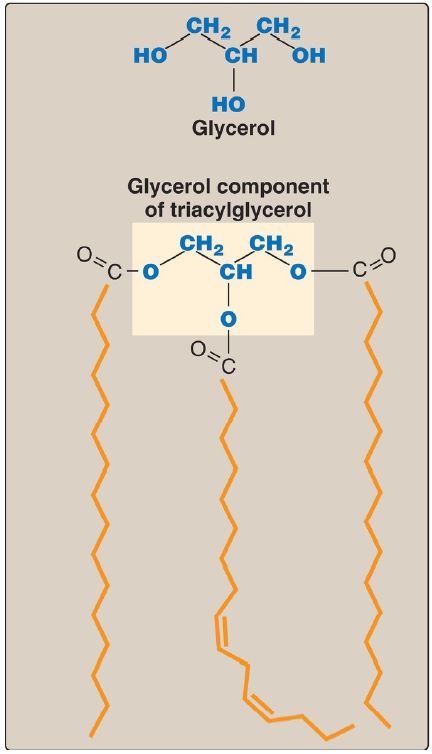


 النبات
النبات
 الحيوان
الحيوان
 الأحياء المجهرية
الأحياء المجهرية
 علم الأمراض
علم الأمراض
 التقانة الإحيائية
التقانة الإحيائية
 التقنية الحيوية المكروبية
التقنية الحيوية المكروبية
 التقنية الحياتية النانوية
التقنية الحياتية النانوية
 علم الأجنة
علم الأجنة
 الأحياء الجزيئي
الأحياء الجزيئي
 علم وظائف الأعضاء
علم وظائف الأعضاء
 الغدد
الغدد
 المضادات الحيوية
المضادات الحيوية|
Read More
Date: 27-12-2021
Date: 22-11-2021
Date: 11-10-2021
|
Fatty Acid synthesis (Storage as triacylglycerol components)
Mono-, di-, and triacylglycerols consist of one, two, or three molecules of fatty acid esterified to a molecule of glycerol. Fatty acids are esterified through their carboxyl groups, resulting in a loss of negative charge and formation of neutral fat. [Note: An acylglycerol that is solid at room temperature is called a fat. If liquid, it is an oil.]
1. Arrangement: The three fatty acids esterified to a glycerol molecule to form a TAG are usually not of the same type. The fatty acid on carbon 1 is typically saturated, that on carbon 2 is typically unsaturated, and that on carbon 3 can be either. Recall that the presence of the unsaturated fatty acid(s) decrease(s) the Tm of the lipid. An example of a TAG molecule is shown in Figure 1.

Figure 1: A triacylglycerol with an unsaturated fatty acid on carbon 2. Orange denotes the hydrophobic portions of the molecule.
2. Triacylglycerol storage and function: Because TAG are only slightly soluble in water and cannot form stable micelles by themselves, they coalesce within white adipocytes to form large oily droplets that are nearly anhydrous. These cytosolic lipid droplets are the major energy reserve of the body. [Note: TAG stored in brown adipocytes serve as a source of heat through nonshivering thermogenesis .]
3. Glycerol 3-phosphate synthesis: Glycerol 3-phosphate is the initial acceptor of fatty acids during TAG synthesis. There are two major pathways for its production (Fig. 2). [Note: A third process (glyceroneogenesis) is described on p. 190.] In both liver (the primary site of TAG synthesis) and adipose tissue, glycerol 3-phosphate can be produced from glucose, first using the reactions of the glycolytic pathway to produce dihydroxyacetone phosphate ([DHAP]).
DHAP is reduced by glycerol 3-phosphate dehydrogenase to glycerol 3-phosphate. A second pathway found in the liver, but not in adipose tissue, uses glycerol kinase to convert free glycerol to glycerol 3- phosphate (see Fig. 2). [Note: The glucose transporter in adipocytes (GLUT-4) is insulin dependent . Thus, when plasma glucose levels are low, adipocytes have only a limited ability to synthesize glycerol phosphate and cannot produce TAG de novo.]

Figure 2: Pathways for production of glycerol 3-phosphate in liver and adipose tissue. [Note: Glycerol 3-phosphate can also be generated by glyceroneogenesis.] NAD(H) = nicotinamide adenine dinucleotide; ADP = adenosine diphosphate.
4. Fatty acid activation: A free fatty acid must be converted to its activated form (bound to CoA through a thioester link) before it can participate in metabolic processes such as TAG synthesis.
5. Triacylglycerol synthesis: This pathway from glycerol 3-phosphate involves four reactions, shown in Figure 3. These include the sequential addition of two fatty acids from fatty acyl CoA, the removal of phosphate, and the addition of the third fatty acid.

Figure 3: Synthesis of TAG. R1–R3 = activated fatty acids. CoA = coenzyme A; Pi = inorganic phosphate.



|
|
|
|
لصحة القلب والأمعاء.. 8 أطعمة لا غنى عنها
|
|
|
|
|
|
|
حل سحري لخلايا البيروفسكايت الشمسية.. يرفع كفاءتها إلى 26%
|
|
|
|
|
|
|
جامعة الكفيل تحتفي بذكرى ولادة الإمام محمد الجواد (عليه السلام)
|
|
|